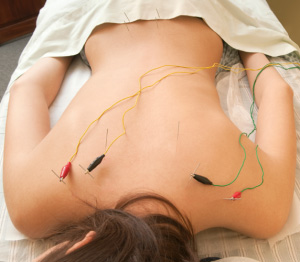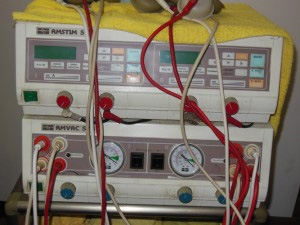

Electro Acupuncture is stimulation of certain acupuncture points by low level electrical current for certain medical benefit. The needles are inserted on specific acupuncture points along the body. Electroacupuncture uses two needles at time so that the impulses can pass from one needle to the other. The needles then attached to a device using small clips and that generates different electric pulses. Devices adjust the frequency and intensity of the impulse being delivered, depending on the condition to be treated. Several pairs of needles can be stimulated simultaneously for about 20 minutes.
Because the current delivered through the needle stimulates a larger area than the needle itself. Therefore practitioner does not have to be as precise with the point of insertion of needles. Moreover Electroacupuncture can be employed without using technique called trans-cutaneous electrical nerve stimulation, or TENS. It uses electrodes that are taped to the surface of the skin instead of being inserted. People with phobia of needles can use this method.
It has been effectively used as a pain reliever for muscle spasms; and a treatment for neurological disorders, as a form of anaesthesia. Other studies have examined the role of Electroacupuncture in treating acute nausea caused by cancer medications skin conditions such as acne and renal colic. Electrical stimulation of acupuncture points could lower blood pressure and reduce heart disease as it activates the endorphin system.
There is no pain or even discomfort. You may experience a tingling or numbness sensation while being treated with Electroacupuncture, due to the electric current. We gradually increase intensity of current from zero till when you start feeling the tingling sensation. We will keep level to comfortable level you want.
Electroacupuncture is not be used on patients with pacemakers, heart disease or strokes or on patients who have a history of seizures, epilepsy. It should also not be performed on directly over the heart, a patient’s head or throat. The current should not travel across the midline of the body, when needles are being connected to an electric current

Electro-acupuncture is a specialized therapeutic method in which a small electrical charge is applied to needles that are already inserted into specific points and have attained De Qi. Electro-acupuncture is advantageous in treating conditions that benefit from acupuncture and electrical stimulation.
Val Hopwood PhD FCSP Dip Ac Nanjing, Clare Donnellan MSc MCSP Dip Shiatsu MRSS, in Acupuncture in Neurological Conditions Electroacupuncture in neurological conditions Electroacupuncture has been used widely for neurological conditions in China and has also been used in many of the research trials on acupuncture for stroke. In practical terms electroacupuncture seems to be useful for sensory and motor problems. Evidence shows that lack of afferent information from areas of impaired sensation or movement results in reorganization of cortical maps. Interventions to increase somatosensory stimulation are being used increasingly to influence sensory and motor function, with promising results in some studies . Electroacupuncture could provoke a strong stimulus in this regard, providing afferent information from skin and muscle contraction.
Yajuan Wang OMD, LAc, in Micro-Acupuncture in Practice, 2009 ELECTRO-ACUPUNCTURE THERAPY: Electro-acupuncture therapy is a technique that is done by inserting the acupuncture needles in the scalp and then connecting the electro-machine to stimulate the point. Use electro-stimulation instead of hand stimulation to treat disease. The electro-machine can perform fast rotation, stabilize the treatment, and control the stimulation. Select two or more points at the time of stimulation. The current level should be chosen based on the amount the patient can handle. Usually choose a small amount of current to stimulate the point for 1 to 2 minutes, and once the patient becomes accustomed to the stimulation, increase the current. Treatment time for electro-acupuncture therapy should be 10 to 20 minutes. Use electro-acupuncture for conditions such as headache, dizziness, tinnitus, deafness, seizures, chorea, facial spasm, hysteria, stroke, or aphasia. Treat the patient once daily or every other day for 10 treatments per course with 7 to 10 days between courses. Electro-acupuncture therapy should be used with caution for the following conditions:
1. Points close to the medulla such as Du 15 (Ya Men) and Du 16 (Feng Fu).
2. On the lower lateral line of the occipital area, use caution with the intensity of current used. Choose the right amount of current so that the patients feel comfortable. Take care not to increase the current suddenly or in large amounts, because there is a dangerous possibility that it can cause the heartbeat or breathing to stop.
3. Electro-acupuncture is contraindicated for patients with cancer or severe heart disease.
4. During the treatment, the practitioner should be careful not to bend or break the needles.
Electro-acupuncture shares the same range of indications as filiform needling, so it can be used to treat a broad spectrum of conditions. The most notable conditions are all types of pain; Bi syndromes; Wei syndromes; disease conditions of the stomach, intestines, gallbladder, urinary bladder, and uterus; and injuries to the muscles, ligaments, and joints. It is also used in acupuncture anesthesia.
The micro-acupuncture system is widely used in electro-acupuncture, especially in the scalp acupuncture system, Jiaji acupuncture system, and back Shu system. There are good results when using electro-stimulation for central nerve disorders, especially with scalp acupuncture. It is also common to combine electro-acupuncture with the macro-acupuncture system.
Normally a dense wave or dense-sparse wave is used to stop pain. Use a dense-sparse wave to increase circulation, in addition a dense-sparse wave or serrated wave is used to increase absorption of fluid. Use the intermittent wave, serrated wave, or sparse wave to increase muscle activity. A sparse wave is used to stimulate connective tissues.
In addition, turn the output off to zero before use. When regulating the intensity of the electrical charge, any increase must be performed slowly and carefully. A sudden, rapid increase in the intensity of the electrical current can cause an abrupt, painful muscular contraction that may result in a bent or broken needle, or even cause the patient to faint. To avoid causing a short, do not allow the paired needles to come into contact with each other.
An Introduction to Western Terry Oleson PhD, in Auriculotherapy Manual (Fourth Edition), 2014
Sunil T. Pai MD, inIntegrative Medicine (Fourth Edition), 2018
Patients can receive six courses of classical acupuncture analgesia to both lower limbs over a 10-week period. In addition to classical acupuncture, a small, clinical, pilot study of biweekly electroacupuncture treatments for 4 weeks demonstrated a reduction in continuous pain from 32.9% to 15.9% and a decrease in the intensity of pain attacks from 59% to 44%. Electroacupuncturemay have a positive influence on nerve conduction velocity and may also relieve neuropathic pain. Electroacupuncture is performed in two cycles of five sittings each (10 sessions) at 2-day intervals. Most clinical studies provided one to two treatments per week for 10–20 weeks.
There is clinical evidence that an acupuncture subspecialty called neuroacupuncture (Chinese scalp acupuncture) has remarkable effects on central nervous systems disorders. A more comprehensive mixture of body acupuncture and neuroacupuncture (with or without electrical stimulation) can improve clinical outcomes by using the following protocol. In my clinical experience, this works very well. Neuroacupuncture points are the upper one-fifth sensory area (S 1/5) for the lower limbs, middle two-fifths sensory area (S 2/5) for the upper limbs, and foot motor and sensory areas; ear points: ShenMen, sympathetic, foot; body points: GB-40, GB-34, SP-10, SP-6, ST-44, LR-3, and Bafeng (extra point). Electrical stimulation can be used for the ear and body points at a frequency of 100 Hz at low intensity for 10–15 minutes in order to achieve an enhanced response.
Before such therapies can be recommended, a constitutional evaluation by a practitioner who is trained in acupuncture, or more specifically neuroacupuncture, should be considered because each modality is prescribed on the basis of the unique symptoms and physical characteristics of the patient. A comprehensive review of medical acupuncture and scalp acupuncture for physicians may be found in the various texts by Dr. Joseph Helms and Dr. Jason Hao.
Jan Zbigniew Szopinski MD, PhD, in The Biological Action of Physical Medicine, 2014
The most recommended classical APs to be stimulated in the case of nicotine addiction, subject to tenderness and “Acute”/“Subacute” readings on the OED device, are as follows (Figure 5.79): T 15 (can be stimulated bilaterally with TENS), G 43, G 8, P 6, L 7, and GV 20. However, an additional (nonclassical) AP called Yintang should also be used; it is located on the Governing Vessel (GV), between the eyebrows. For “heavy” smokers, another two “extra” points can be added, which are located symmetrically on the outer sides of nostrils on the verge of nasal bones.
The recommended antinicotinic therapy also includes a very important auricular acupuncture: on the left ear auricle, OPAs corresponding to the bronchi and the stomach should be stimulated (see Figure 4.8); on the right one, OPAs related to the lungs (lower lobes) and the gallbladder should be stimulated. Auricular electroacupuncture can be done with small standard needles (3–4 cm long), which can be connected to the electrostimulator (see Section 5.8.1.2.3) along with all the other needles inserted into corporal APs.
This treatment seems to block the nicotinic hunger. Therefore, 10 minutes after the beginning of such a stimulation, the patient (still under treatment) should be asked to smoke one or two cigarettes; this will be like the first cigarette in his or her life, with intensive perspiration, dizziness, nausea, and sometimes vomiting and even fainting occurring before the smoking is finished. Then, following the famous example of Pavlov’s dogs, the same procedure should be repeated three times per week, at least several times, until the patient develops a reflex permanently preventing him or her from attempting to smoke.
Karen Pilkington, in International Review of Neurobiology, 2013
Types of electric stimulation
The effect of transcutaneous electrical nerve stimulation does not extend as deeply into tissue as percutaneous electrical nerve stimulation, which has the same anaesthetic effects, primarily at the level of skin and fascia. However, this modality may be preferable in clinical scenarios where needle puncture is not well tolerated or is inadvisable due to contraindications.
Basically, this method of electric acupuncture uses the same principles as conventional acupuncture. The only difference is that an electric signal, similar to the actual nerve impulse, is used to stimulate the channels. Under certain conditions this is the preferred choice of therapy.
The TENS unit measures skin resistance, which is generally lower at the specific acupuncture point. Once the spot has been found, a steady electric impulse is passed onto the body channel. The strength of the impulse can be set. The patient has a tingling type of sensation, like ‘pins and needles', which is usually felt along the channel.
As well as its application to relieve postoperative pain, this technique can be used as a drug-free treatment for anxiety, depression and insomnia after the operation. Its mechanism of action is widely thought to be its ability to bring neurotransmitters in stressed subjects back to normal, pre-stress levels of homeostasis.